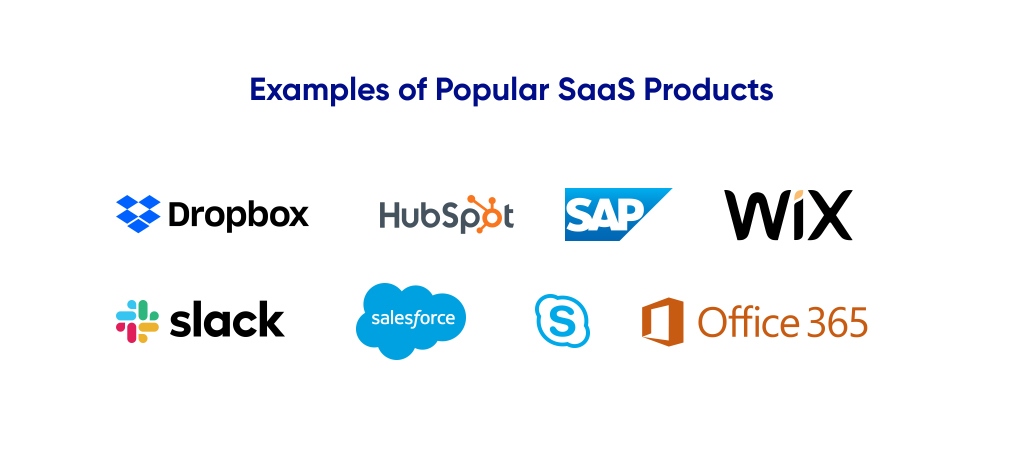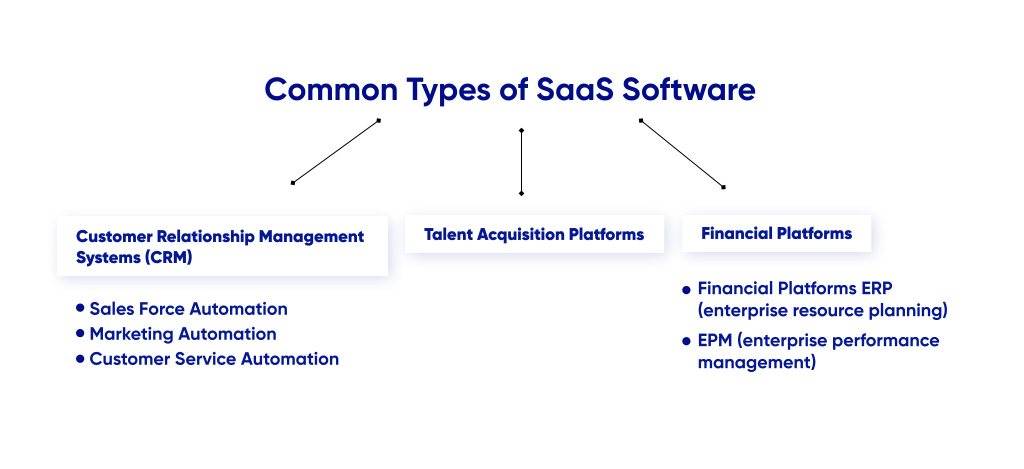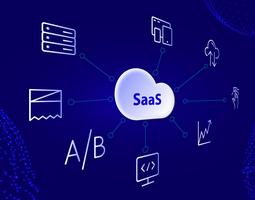Whether you are a business person or a consumer, you have likely used a SaaS solution at least once in your life. SaaS has been all the rage for well over a decade, and it is becoming even more popular as companies, from start-ups to large enterprises, are considering SaaS development for their businesses.
If you are wondering why companies are opting for this solution, and what kind of benefits SaaS offers to businesses, this article is for you. You will also find answers to questions on the most common types of SaaS apps and how you can build one. Without further ado, let’s get right into it.
What is a SaaS Application?
You might be familiar with such solutions as Wix, HubSpot, Dropbox, Salesforce, SAP, Slack, Skype for Business, the cloud-based Microsoft Office 365, and many more. All these are different software products in terms of what they offer to the customer, but they are all just SaaS applications.

SaaS is an abbreviation for Software as a Service. Simply put, it is one of the three main categories in cloud computing (the other two are PaaS and IaaS) that allows users to subscribe to a software product and use it on the cloud. This means the customer is able to access a SaaS solution from any device and anywhere, be it their home, office, or a public place. All that they will need is a stable internet connection.
What also distinguishes SaaS apps from more traditional on-demand apps is that they are available upon subscription; you can pay for several users on a monthly or yearly basis and cancel anytime you want.
Why Now Is the Time for SaaS Application Development?
The last few years of the pandemic have shown us that if you want to save your business, going online is non-negotiable. Thankfully, the swiftness of SaaS software development allows firms to adopt various software solutions in a blink of an eye.
Cloud technology itself is a solid basis for digital transformation, as it provides firms of different sizes and industries with SaaS software for impressive growth and positive changes. For instance, According to Gartner’s worldwide public cloud services end-user spending forecast, Software as a Service will continue to dominate the entire 2023. It will also exceed other categories of computing — PaaS, IaaS, BPaaS (Cloud Business Process Services), Cloud Management and Security Services, and DaaS (Desktop as a Service).
Worldwide Public Cloud Services End-User Spending Forecast (USD million)
| 2020 | 2021 | 2022 | |
| Cloud Application Services (SaaS) | 120,686 | 145,509 | 171,915 |
| Cloud System Infrastructure Services (IaaS) | 64,286 | 91,543 | 121,620 |
| Cloud Application Infrastructure Services (PaaS) | 58,917 | 80,002 | 100,636 |
| Cloud Business Process Services (BPaaS) | 46,066 | 51,027 | 55,538 |
| Cloud Management and Security Services | 22,664 | 25,987 | 29,736 |
| Desktop as a Service (DaaS) | 1,235 | 2,079 | 2,710 |
| Total Market | 313,853 | 396,147 | 482,155 |
However, apart from digital transformation, companies must adopt SaaS technology for three more reasons:
Adopting SaaS for Customer-Oriented Business Approach
The times when companies dictated the rules of business and when the customer had to reckon with those rules are long gone. Nowadays, everything has changed. Due to fierce competition, firms are fighting tooth and nail for both new clients and existing ones. This is because customer expectations have dramatically grown due to digital transformation and the tough competition between businesses.
It is paramount to place the client in the centre of any business and provide them with an exceptional customer experience, which is as important as the companies' products and services.
Adopting SaaS to Stay Competitive
Digital transformation has become affordable and accessible as professional SaaS cloud app development services have allowed many to enter the business market, thereby increasing competition. At that, Software as a Service can help you stay competitive — you can deliver your products or services as fast as ever before.
Adopting SaaS for Paying Attention to the Core Processes
The main advantage of SaaS is that it is usually built using state-of-the-art technologies with embedded artificial intelligence, data-driven analytics, etc. The same goes with updates and tech issues — the SaaS provider takes complete responsibility for these things. In the end, what you get is an innovative solution built using the latest technologies, and the provider of the solution will take care of any upgrades and tech issues.
So, does this mean that you won’t need an IT department anymore? On the contrary. Now that you have your tech professionals no longer busy with SaaS app development, including updating and maintaining your product, they can start devoting one-hundred-percent of their time to your core business processes. For instance, they can work on a new product or service or improve an existing one.
The Most Common Types of SaaS Solutions
When it comes to major software-as-a-service solutions, we can distinguish three common types of such apps that can be created during SaaS development. We will now consider them in more detail:

Customer Relationship Management Systems
A customer relationship management system, or CRM for short, is a piece of software that aligns a company's sales, marketing, and service departments to provide an impeccable customer journey to its clients and streamlines business processes for these departments.
Thus, a full-fledged custom CRM software consists of three main components: sales force, marketing, and service automation.
Sales Force Automation
Sales representatives are probably the only caste of professionals who are always on the go. They move from town to town, city to city, state to state, and even across continents. They visit multiple locations and sales points, and have dozens of important meetings and calls every day. They are the ones who need access to sophisticated software as fast as they can without being restricted to a single place.
CRM for sales force automation provides salespeople with the full mobility, flexibility, and accessibility of the cloud. They can easily use a CRM from their mobile phone, tablet, or personal computer and access it from everywhere, be it a cafe, meeting room, or even their kitchen.
A sales automation solution allows your sales representatives to always keep an eye on every business deal they have, make timely follow-ups, and have all necessary data literally at their fingertips.
However, CRM for sales is more than just calendars, meeting schedules, and information about accounts and contacts. If you are a sales director, this solution is just irreplaceable for you. It will help you determine your A-players in sales, close more deals, and eliminate various bottlenecks by introducing new initiatives. And SaaS application development is the right thing to use to build a sales force automation product for your specific needs.
Marketing Automation
If you want to have a successful business, then sales and marketing should go hand in hand. Unfortunately, many companies do not realise the importance of marketing endeavours, and focus solely on selling their products and services. Business owners primarily motivate their reluctance to use marketing by saying that it is too expensive and requires time, which is partially true.
But with an advanced and cost-efficient CRM solution for marketing automation, companies can and should use its functionality for cost-effective and versatile marketing campaigns: personalised email marketing, event marketing, lead nurturing, trigger emails, etc.
As a result, a customer relationship management system is a perfect option to start doing successful campaigns right away and finally connect marketing & sales departments.
Customer Service Automation
It is common knowledge that providing an exceptional experience to the client before and after the sale is essential; otherwise, they might turn to your competitor who offers better support. Or in addition, they can give your business a bad name by posting about your awful customer care on various social media accounts.
To avoid this worst-case scenario, adopting CRM for customer service automation is a win-win. First, such a system can provide your business with various channels to help your clients. This might be a self-service portal, where users can find answers to their queries, chats & calls with service agents or bots.
A customer service automation solution will help you meet your customers’ needs and respond to their queries efficiently and timely, which leads to higher customer satisfaction and loyalty. And comprehensive SaaS app development services will help you create a turn-key customer service solution for your specific business needs and objectives.
Talent Acquisition Platforms
Covid-19 has proven to have some positive impacts on business. Even when the pandemic dies down, many companies are not planning to return to offices and will continue working remotely.
This new working mode allows businesses to be extremely flexible in hiring new talent. Using SaaS technology, they can bring into their teams' new employees from anywhere in the world. A full-fledged Software-as-a-Service solution can help with entire HR processes, including video conferencing, collaboration tools, scheduling, onboarding & education modules, etc.
Financial Platforms
The financial department has always been the driving force of any organisation. Chief financial officers are responsible for generating handsome profits, maintaining absolute control over costs, and developing effective financial and corporate strategies for the organisation. The SaaS solution that they choose for these purposes is ERP.
A software-as-a-service ERP or enterprise resource planning system is a cloud system used to address various financial challenges and solve problems effectively. At the core of any ERP system lies a database that includes information about all the financial, inventory, sales, and payment records of an organisation. ERP integrates these data sets to produce illuminating insights on boosting efficiency and decreasing costs. An enterprise resource planning system has advanced analytics generating detailed reports regularly.
Another practical SaaS app for finance is EPM, or Enterprise Performance Management. According to Gartner , this is a solution that aggregates and integrates data from various sources such as e-commerce platforms, front-office, and back-office apps, as well as data warehouses and third-party apps. The system’s main objective is to help stakeholders understand the entire performance. Thus, the benefits of ERP are enormous.
All in all, ERP and EPM are an integral part of any financial initiatives within a company. SaaS application development will help you build the ERP or EMP system you need.
How to Develop a SaaS Solution: Step-by-Step Guide
Creating a SaaS product might be a complicated, time-consuming, and risky endeavour if you do not have the slightest idea of where to start. This small step-by-step SaaS development guide will help you get started in the intricate software-as-a-service development process.

Ideation
Before creating a SaaS application, you need to understand what you want to build. Is it going to be a CRM system, financial platform, or something else? Do you need a functional prototype, a minimum viable product, or a full-released version? Are there any user roles?
You should also consider what platforms you will be using — iOS, Android, tablet app, web, or all of them together. Also, pay attention to how your users will be logging in — via a phone message, social media account, email, or the combination of these three options.
It is also important to consider in advance your customer support & geo-location features, payment or monetisation models, scheduling apps, push notifications, integrations with third-party solutions, levels of security, analytics, and dashboards. Hope you got the gist.
Choosing Tech Stack and Team Assembly
Once you’ve decided on what you want to build, you need to choose the right technology stack for your project. You should also remember that this step is crucial as it will shape and define the entire SaaS app development process and will influence what kind of team will be working on translating your project from an idea into a reality.
The most commonly-used technologies for mobile development are React Native, Flutter, Swift, Java, Android SDK, and iOS SDK.
For front-end development, which is the client-side part of any website, webpage, or anything the end-user interacts with, you can use the following technologies: HTML & CSS, JavaScript, TypeScript, ReactJS, Angular, VueJS, Redux, Flow, etc.
And for the back-end, you can opt for Python, PHP, Node.js.
Once you’ve decided on the right tech stack for your project, it is time to assemble your team. You can do this in three ways:
- In-house hiring
- Freelancers
- Outsource development
That done, you need to consider a few more factors that play a huge role in SaaS development. You need to choose the right server to enable communication between the user and your Software-as-a-Service solution.
Many companies prefer using cloud providers such as Amazon Web Services and Microsoft Azure, but you can also choose Apache or Nginx as your primary choice.
Next, you need to opt for a database to store information and keep it organised — MySQL, Azure SQL Database, PostgreSQL, and MongoDB are just a few prime examples of databases.
Last but not least, you need to choose the right Software architecture for SaaS development. There are two choices: single-tenant and multi-tenant.
Software Development Process
This is the part of the process where your team is actually creating your product, be it a prototype, an MVP, or a full-fledged solution.
A minimum viable product is a good start when you are still unsure about your solution. An MVP will include only the most necessary and essential features of your product and will allow you to test these features on real users. Once they have given you positive feedback, you can then continue with the software development process. Otherwise, you can iterate and pivot so that your product can suit the users’ needs.
When creating a full-released solution, your team will start coding and use the latest technologies such as programming languages, frameworks, and methodologies to turn the MVP into a real product.
Testing, Debugging, and Deployment
The objective of this stage is to ensure that your SaaS app is bug-free, runs smoothly, and can be deployed and released into the world. Your QA team should test the app’s data security, scalability, performance, and compatibility. Thus, quality assurance specialists will try out the entire cloud-based infrastructure. Once the product is created and tested, it is time to deploy it to users.
Software Maintenance
The last SaaS development stage is maintenance. This is an ongoing stage, as the software requires updating, upgrading, and de-bugging to keep it up-to-date to ensure your users have the best experience.
SaaS App Development Costs
Efficient SaaS development services are not inexpensive, but they should not cost a fortune either. And as they say “The truth is usually somewhere between the two sides”. To understand how much money you need to spend on your software-as-a-service solution, you must consider the entire scope of your work, features that you want to have, the final outcome, and the amount of time you need to complete the project.
The most cost-effective mode of hiring is outsourcing, which can provide you with one of the next engagement models:
Fixed-Price
If you opt for the Fixed-price model, you will get complete SaaS development services for a fixed price. You decide on the requirements for your project in advance and you cannot change them later.
Time & Materials
Deciding on the Time & Materials model, you will be able to spend a budget on the features you want step-by-step during development. You will also be able to implement changes along the way.
Dedicated Team
Your budget will depend on the number of experts involved in your project, their hourly rates, and the project length.
Outstaffing
If outsourcing is not a good option for you, then you can choose outstaffing. This is hiring software engineers from a software development agency who will be your in-house employees working remotely and following your policy, timetable, agenda, etc.
How to Choose a SaaS Development Company?
When looking for a reliable Saas Development company, you are sure to stumble upon myriads of firms specialising in software development. So how do you choose the right agency? We recommend paying attention to the following things:
Company’s Portfolio
When looking for the ideal SaaS development company, the first thing you must check is their case studies, or a portfolio of the products they’ve created. This way, you will be able to understand if they are proficient in creating Software-as-a-Service solutions such as CRMs, talent acquisition platforms, financial and healthcare cloud applications, and many others.
Customer Reviews
Social proof is no less important than a company’s portfolio or case studies. To find what other people say about your potential partner, you can search for reviews on their websites or popular review platforms such as Clutch, Glassdoor, or Goodfirms. For instance, Clutch is one of the most objective and unbiased review platforms. Clutch’s users rate companies according to the quality of services, rates, cost, and willingness to refer, and also provide honest and detailed feedback.
Company’s Awards
Various prizes speak louder than words. Many organisations hold diverse competitions and nominate software development companies for special awards, which are the tokens of objectivity and unbiasedness.
Many renowned companies such as Clutch, Goodrims, Techreviewer, and others such as Manifest, Business of Apps, App Development Companies, Top Developers, Top App Development Companies, Upсity recognise the unrivalled experience and considerable expertise of SaaS development companies by awarding them prestigious prizes. For instance, Clutch’s top-1000 software providers is an award that is handed out to only 1 percent of all the firms represented on the platform. As such, you can easily picture the number of companies in the world offering SaaS software development services.
Company’s Services and Technologies
When seeking the right vendor, you must pay thorough attention to the services they provide and the technologies they will use for creating your SaaS project. If you are looking to build a comprehensive marketplace, financial, or healthcare solution, check if they have them in their case studies or portfolio.
You should also check in advance what kind of technologies they use for building software. If you need a mobile platform, see if they can provide you with cross-platform and native, mobile app development and what tools they pick when producing an application.
If you are looking to have a refined AI product, your ideal SaaS development agency must have broad experience in AI, ML, Data Science, etc.
Company’s Years on the IT Market
Here, apply the “the more the better” rule. The more years they have operating in the IT market, the better it is for companies who are looking for a reliable SaaS development partner. Companies that have been providing their services for a while have a vast assortment of projects in their arsenal and the necessary experience in diverse techs that allow them to create a solution of any complexity.
Wrapping Up
SaaS is the new era in cloud computing. SaaS apps are cost-effective solutions that can be accessed from any device and from anywhere in the world. SaaS provides users with flexibility and important functionality to run customer relations, financial, hiring, and other processes as smoothly and effectively as possible. If you are looking to build a SaaS app of any complexity and need comprehensive SaaS app development services, we would be glad to help you in your endeavour. Just drop us a line here.

.png)



